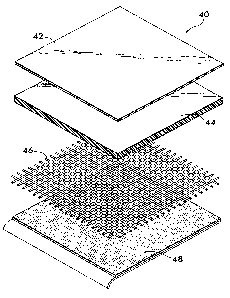Some of the information on this Web page has been provided by external sources. The Government of Canada is not responsible for the accuracy, reliability or currency of the information supplied by external sources. Users wishing to rely upon this information should consult directly with the source of the information. Content provided by external sources is not subject to official languages, privacy and accessibility requirements.
Any discrepancies in the text and image of the Claims and Abstract are due to differing posting times. Text of the Claims and Abstract are posted:
| (12) Patent Application: | (11) CA 2559051 |
|---|---|
| (54) English Title: | HEAT SHIELD HAVING A SEALED EDGE |
| (54) French Title: | BOUCLIER CHAUD A BORDURES SOUDEE |
| Status: | Deemed Abandoned and Beyond the Period of Reinstatement - Pending Response to Notice of Disregarded Communication |
| (51) International Patent Classification (IPC): |
|
|---|---|
| (72) Inventors : |
|
| (73) Owners : |
|
| (71) Applicants : |
|
| (74) Agent: | GOWLING WLG (CANADA) LLP |
| (74) Associate agent: | |
| (45) Issued: | |
| (86) PCT Filing Date: | 2005-03-10 |
| (87) Open to Public Inspection: | 2005-11-24 |
| Availability of licence: | N/A |
| Dedicated to the Public: | N/A |
| (25) Language of filing: | English |
| Patent Cooperation Treaty (PCT): | Yes |
|---|---|
| (86) PCT Filing Number: | PCT/US2005/007993 |
| (87) International Publication Number: | US2005007993 |
| (85) National Entry: | 2006-09-08 |
| (30) Application Priority Data: | ||||||
|---|---|---|---|---|---|---|
|
A heat shield is disclosed having a first layer with a reflective surface, a
second, heat fusible layer, a third insulating and reinforcing layer, and a
fourth layer formed of pressure sensitive adhesive. The edges of the layers
align with one another to form a common perimeter to which heat and pressure
are applied to fuse the heat fusible layer to the other layers and bond the
layers to one another. The heat fusible layer forms a seal on the perimeter
that prevents the diffusion of fluids between the layers.
Un bouclier chaud ayant une première couche avec une surface reflétante est, une deuxième couche thermofusible, une troisième couche calorifuger et renforcée, et une quatrième couche formée de pression adhésive sensitive sont exposés. Les bordures des couches s~alignent les unes avec les autres pour former un périmètre commun à laquelle la chaleur et la pression sont appliquées pour combiner la couche de chaleur thermofusible aux autres couches et lie les couches à une autre. La couche thermofusible forme une soudure sur le périmètre ce qui évite la diffusion de fluides entre les couches.
Note: Claims are shown in the official language in which they were submitted.
Note: Descriptions are shown in the official language in which they were submitted.

2024-08-01:As part of the Next Generation Patents (NGP) transition, the Canadian Patents Database (CPD) now contains a more detailed Event History, which replicates the Event Log of our new back-office solution.
Please note that "Inactive:" events refers to events no longer in use in our new back-office solution.
For a clearer understanding of the status of the application/patent presented on this page, the site Disclaimer , as well as the definitions for Patent , Event History , Maintenance Fee and Payment History should be consulted.
| Description | Date |
|---|---|
| Time Limit for Reversal Expired | 2010-03-10 |
| Application Not Reinstated by Deadline | 2010-03-10 |
| Deemed Abandoned - Failure to Respond to Maintenance Fee Notice | 2009-03-10 |
| Letter Sent | 2007-04-05 |
| Inactive: Single transfer | 2007-02-23 |
| Inactive: Courtesy letter - Evidence | 2006-11-07 |
| Inactive: Cover page published | 2006-11-06 |
| Inactive: Notice - National entry - No RFE | 2006-11-01 |
| Inactive: Applicant deleted | 2006-11-01 |
| Inactive: IPRP received | 2006-10-27 |
| Amendment Received - Voluntary Amendment | 2006-10-25 |
| Application Received - PCT | 2006-10-06 |
| National Entry Requirements Determined Compliant | 2006-09-08 |
| National Entry Requirements Determined Compliant | 2006-09-08 |
| Application Published (Open to Public Inspection) | 2005-11-24 |
| Abandonment Date | Reason | Reinstatement Date |
|---|---|---|
| 2009-03-10 |
The last payment was received on 2008-01-08
Note : If the full payment has not been received on or before the date indicated, a further fee may be required which may be one of the following
Patent fees are adjusted on the 1st of January every year. The amounts above are the current amounts if received by December 31 of the current year.
Please refer to the CIPO
Patent Fees
web page to see all current fee amounts.
| Fee Type | Anniversary Year | Due Date | Paid Date |
|---|---|---|---|
| Basic national fee - standard | 2006-09-08 | ||
| Registration of a document | 2006-09-08 | ||
| MF (application, 2nd anniv.) - standard | 02 | 2007-03-12 | 2007-01-19 |
| MF (application, 3rd anniv.) - standard | 03 | 2008-03-10 | 2008-01-08 |
Note: Records showing the ownership history in alphabetical order.
| Current Owners on Record |
|---|
| FEDERAL-MOGUL POWERTRAIN, INC. |
| Past Owners on Record |
|---|
| JOHN E. BURDY |
| SAMUEL B., JR. FRYBERGER |
| TIMOTHY D. SELLIS |